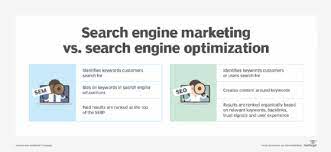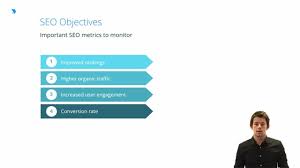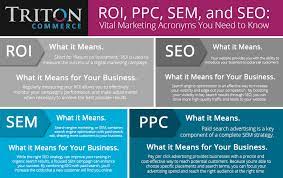SEM: Search Engine Marketing
In today’s digital age, having a strong online presence is crucial for businesses of all sizes. One effective way to boost your visibility and reach your target audience is through Search Engine Marketing (SEM). SEM encompasses a range of strategies and techniques designed to increase your website’s visibility in search engine results pages (SERPs). In this article, we will explore the concept of SEM and its importance in the ever-evolving digital landscape.
What is SEM?
SEM, also known as paid search or pay-per-click (PPC) advertising, involves promoting your website through paid advertisements that appear on search engine results pages. These ads are typically displayed at the top or bottom of the SERPs and are marked as “sponsored” or “ad.” Unlike organic search results, which are determined by complex algorithms, SEM allows you to bid on keywords relevant to your business and target specific demographics.
Why is SEM important?
Increased Visibility: With billions of searches conducted every day, search engines have become the go-to resource for users seeking information, products, or services. By investing in SEM, you can ensure that your website appears prominently when users search for keywords related to your business. This increased visibility can drive more traffic to your site and potentially lead to higher conversion rates.
Targeted Advertising: One of the key advantages of SEM is its ability to target specific audiences based on various parameters such as location, demographics, interests, and even device type. This level of targeting ensures that your ads are shown to users who are more likely to be interested in what you have to offer. By reaching the right audience at the right time, you can maximize the effectiveness of your marketing efforts.
Measurable Results: Unlike traditional forms of advertising where it can be challenging to measure ROI accurately, SEM provides detailed insights into campaign performance. With robust analytics tools available, you can track metrics such as impressions, clicks, click-through rates (CTRs), and conversions. This data allows you to make informed decisions, optimize your campaigns, and allocate your budget more effectively.
Flexibility and Control: SEM offers a high level of flexibility and control over your advertising campaigns. You can set daily budgets, adjust bids for specific keywords, and even schedule your ads to appear during certain times of the day or week. This level of control allows you to experiment, refine your strategies, and ensure that your marketing efforts align with your business goals.
Tips for Successful SEM Campaigns:
Keyword Research: Thorough keyword research is essential for SEM success. Identify relevant keywords that have high search volume but are not overly competitive. Long-tail keywords can be particularly effective in targeting specific niches.
Compelling Ad Copy: Craft compelling ad copy that grabs attention and entices users to click on your ads. Highlight unique selling points, promotions, or special offers to differentiate yourself from competitors.
Landing Page Optimization: Ensure that the landing pages users are directed to after clicking on your ads are relevant, user-friendly, and optimized for conversions. A seamless user experience can significantly impact the success of your campaigns.
Continuous Monitoring and Optimization: Regularly monitor the performance of your SEM campaigns and make data-driven optimizations based on the insights gathered. Test different ad variations, adjust bids, refine targeting parameters, and explore new opportunities to stay ahead of the competition.
In conclusion, SEM is a powerful digital marketing strategy that can help businesses increase their online visibility, drive targeted traffic to their websites, and achieve their marketing objectives. By investing in SEM techniques such as paid search advertising, businesses can effectively reach their target audience at the right time while maintaining control over their marketing budgets. With careful planning, strategic implementation, and continuous optimization efforts, businesses can harness the full potential of SEM to grow their online presence and achieve long-term success in today’s competitive digital landscape.
5 Essential Tips for Successful SEM (Search Engine Marketing)
Focus on keywords
Focus on Keywords: The Key to Successful SEM
When it comes to Search Engine Marketing (SEM), one crucial tip stands out among the rest: focus on keywords. Keywords are the foundation of any successful SEM campaign, as they determine how your ads will be displayed and who will see them. By understanding the importance of keywords and effectively utilizing them, you can maximize the impact of your SEM efforts.
Keywords are the words or phrases that users type into search engines when looking for information, products, or services. They serve as a bridge connecting businesses with their target audience. By selecting relevant and strategic keywords, you can ensure that your ads appear when users search for those specific terms.
To make the most of your keyword strategy, consider these tips:
- Research: Conduct thorough keyword research to identify the most relevant and high-performing keywords for your business. Look for keywords that have a high search volume but are not overly competitive. Tools like Google Keyword Planner can provide valuable insights into keyword performance and help you discover new opportunities.
- Relevance: Select keywords that align closely with your business offerings and target audience. Ensure that your chosen keywords accurately reflect what you offer so that users who click on your ads find what they are looking for on your website.
- Long-Tail Keywords: In addition to broad keywords, consider incorporating long-tail keywords into your strategy. Long-tail keywords are more specific phrases that may have lower search volume but often result in higher conversion rates as they indicate stronger user intent.
- Match Types: Understand different match types when setting up keyword targeting in your SEM campaigns. Broad match allows for variations of the keyword, while phrase match and exact match provide stricter targeting options. Experiment with different match types to find what works best for your campaign goals.
- Negative Keywords: Don’t forget about negative keywords – terms you don’t want triggering your ads. By excluding irrelevant or unwanted searches, you can refine your targeting and improve campaign performance.
- Monitor and Optimize: Continuously monitor the performance of your keywords and make data-driven optimizations. Identify underperforming keywords that are draining your budget or not generating desired results. Experiment with new keywords, adjust bids, and refine your strategy based on the insights gathered.
Remember, focusing on keywords is not a one-time task but an ongoing process. The digital landscape is constantly evolving, and user search behavior changes over time. Regularly review and update your keyword strategy to stay relevant and maintain a competitive edge in the SEM arena.
By prioritizing keywords in your SEM campaigns, you can enhance your visibility in search engine results, reach the right audience at the right time, and drive targeted traffic to your website. So, invest time and effort into understanding the power of keywords and leverage them effectively to achieve success in SEM.
Optimize your website
Optimize Your Website for SEM Success
When it comes to Search Engine Marketing (SEM), optimizing your website is a crucial step that should not be overlooked. Website optimization involves making strategic changes to your site’s structure, content, and design to improve its visibility and performance in search engine results pages (SERPs). In this article, we will explore the importance of website optimization in SEM and provide some tips to help you get started.
Why is website optimization important for SEM?
Improved Visibility: The primary goal of SEM is to increase your website’s visibility in search engine results. By optimizing your site, you can ensure that search engines can easily crawl and index your pages, making them more likely to appear in relevant searches. This increased visibility can drive organic traffic to your site and complement your paid advertising efforts.
Better User Experience: Website optimization goes hand in hand with providing a positive user experience. When users visit your site, they expect it to load quickly, be easy to navigate, and offer valuable content. By optimizing elements such as page speed, mobile responsiveness, and user-friendly navigation, you create a seamless experience that keeps visitors engaged and encourages them to explore further.
Higher Conversion Rates: A well-optimized website can also lead to higher conversion rates. When users land on a page that meets their expectations and provides the information or products they are looking for, they are more likely to take the desired action – whether it’s making a purchase, filling out a form, or subscribing to a newsletter. Optimizing your site’s design and calls-to-action can significantly impact conversion rates.
Tips for optimizing your website for SEM:
Keyword Research: Conduct thorough keyword research to identify relevant terms and phrases related to your business. Incorporate these keywords strategically into your website’s content, including page titles, headings, meta descriptions, and body text. However, ensure that the keywords are used naturally and do not compromise the quality of your content.
Optimize Page Titles and Meta Descriptions: Craft compelling and keyword-rich page titles and meta descriptions for each page of your website. These elements appear in search results and play a crucial role in attracting users to click on your site. Make sure they accurately represent the content on each page and entice users to visit your site.
Improve Page Speed: Slow-loading pages can negatively impact user experience and search engine rankings. Minimize image sizes, leverage browser caching, and optimize code to improve page speed. Tools like Google’s PageSpeed Insights can provide insights into areas that need improvement.
Create Quality Content: Develop high-quality, informative, and engaging content that aligns with your target audience’s needs and interests. Regularly update your website with fresh content to keep visitors coming back for more. Well-written content that incorporates relevant keywords can help boost your site’s visibility in search results.
Mobile Optimization: With mobile usage on the rise, it is essential to ensure that your website is optimized for mobile devices. Responsive design ensures that your site adapts seamlessly to different screen sizes, providing an optimal experience for mobile users.
In conclusion, optimizing your website is a critical component of SEM success. By implementing these tips and continually monitoring and refining your site’s performance, you can enhance its visibility in search engine results, improve user experience, and increase conversion rates. Remember that website optimization is an ongoing process as search engine algorithms evolve, user preferences change, and new technologies emerge. Stay proactive in optimizing your site to stay ahead of the competition and maximize the benefits of SEM for your business.
Utilize link building
Utilize Link Building: A Key Strategy in SEM
When it comes to Search Engine Marketing (SEM), one crucial strategy that can significantly impact your website’s visibility and rankings is link building. Link building involves acquiring high-quality, relevant backlinks from other websites to your own. In this article, we’ll explore the importance of link building in SEM and how it can benefit your overall marketing efforts.
Why is link building important in SEM?
Improved Search Engine Rankings: Search engines consider backlinks as a vote of confidence for your website’s credibility and authority. When reputable websites link to yours, search engines perceive your site as trustworthy and relevant. As a result, your website’s rankings in search engine results pages (SERPs) can improve, leading to increased organic traffic.
Increased Website Visibility: Backlinks act as pathways that guide users from other websites to yours. When you have a network of quality backlinks pointing to your site, you increase the chances of attracting new visitors who may not have discovered your website otherwise. This increased visibility can lead to higher brand exposure and potential conversions.
Referral Traffic: In addition to improving search engine rankings, backlinks can also generate direct referral traffic. When users click on a link from another website and land on yours, they are already interested in the content or products you offer. This targeted traffic has a higher likelihood of engaging with your website and converting into customers.
How to effectively utilize link building:
Create High-Quality Content: Producing valuable and informative content is key to attracting quality backlinks. When you provide unique insights or resources that others find useful, they are more likely to reference or share your content with their audience.
Build Relationships: Actively engage with other website owners or influencers in your industry by reaching out through email or social media platforms. Establishing meaningful connections can lead to opportunities for guest posting, collaboration, or natural link placements.
Submit to Relevant Directories: Submitting your website to reputable directories or industry-specific listings can help improve your online visibility and generate valuable backlinks. Ensure that the directories you choose are trustworthy and relevant to your business.
Monitor Your Backlink Profile: Regularly monitor your backlink profile using tools like Google Search Console or third-party SEO software. This allows you to identify any low-quality or spammy links that may harm your website’s reputation. Disavow any harmful links to maintain a healthy backlink profile.
In conclusion, link building is an essential component of SEM that can significantly impact your website’s visibility, search engine rankings, and overall success. By actively pursuing high-quality backlinks from reputable sources, you not only improve your website’s authority but also increase the chances of attracting targeted traffic and potential customers. Remember to focus on creating valuable content, building relationships with others in your industry, and monitoring your backlink profile regularly. By utilizing effective link building strategies, you can enhance your SEM efforts and achieve long-term success in the competitive online landscape.
Monitor analytics
When it comes to Search Engine Marketing (SEM), one of the most valuable tips for success is to monitor analytics regularly. Analytics provide crucial insights into the performance of your SEM campaigns and help you make data-driven decisions to optimize your strategies.
By monitoring analytics, you gain a deeper understanding of how your ads are performing, which keywords are driving the most traffic, and how users are interacting with your website. This information allows you to identify areas for improvement and make necessary adjustments to maximize your campaign’s effectiveness.
Analytics provide essential metrics such as impressions, clicks, click-through rates (CTRs), conversion rates, and more. By analyzing these metrics, you can determine which keywords and ad variations are generating the best results and allocate your budget accordingly.
Additionally, monitoring analytics helps you identify trends over time. You can track changes in performance, detect seasonality patterns, and understand user behavior. Armed with this knowledge, you can adapt your strategies to capitalize on opportunities or address any challenges that arise.
Regularly reviewing analytics also enables you to stay informed about market trends and competitor activities. By keeping a close eye on industry benchmarks and analyzing how competitors are performing in the same space, you can benchmark your own performance and identify areas where you can gain a competitive edge.
Remember that SEM is an ongoing process that requires continuous monitoring and optimization. By making data-driven decisions based on analytics insights, you can refine your campaigns over time, improve their efficiency, and achieve better results.
In conclusion, monitoring analytics is a critical aspect of successful SEM campaigns. It provides valuable insights into performance metrics, user behavior patterns, industry trends, and competitor activities. By leveraging these insights effectively, businesses can optimize their strategies and achieve their marketing goals in the ever-evolving digital landscape.
Test & adjust
Test & Adjust: The Key to Successful SEM Campaigns
When it comes to Search Engine Marketing (SEM), one of the most critical tips for achieving success is to test and adjust your campaigns continuously. SEM is a dynamic field where trends and user behavior can change rapidly. To stay ahead of the competition and maximize your campaign’s effectiveness, it’s essential to embrace a mindset of constant testing and adjustment.
Testing different elements of your SEM campaigns allows you to gather valuable insights about what works best for your target audience. Here are some key areas to focus on when conducting tests:
- Ad Copy: Experiment with different headlines, descriptions, calls-to-action, and offers in your ad copy. Test variations to determine which ones resonate most with your audience and drive higher click-through rates.
- Landing Pages: Your landing page plays a crucial role in converting visitors into customers or leads. Test different layouts, content placements, forms, and visuals on your landing pages to optimize their performance and increase conversion rates.
- Keywords: Continuously review and refine your keyword strategy based on performance data. Test new keywords, adjust bids for existing ones, and identify negative keywords that may be draining your budget without delivering results.
- Ad Extensions: Take advantage of ad extensions such as sitelinks, callouts, structured snippets, and call extensions to enhance your ads’ visibility and provide additional information to users. Test different combinations of extensions to see which ones generate the highest engagement.
- Targeting Parameters: Refine your targeting parameters based on audience demographics, location, device type, or time of day. By testing different targeting options, you can identify the most effective settings for reaching your desired audience.
Once you’ve conducted tests across various elements of your SEM campaigns, it’s crucial to analyze the data collected and make adjustments accordingly:
– Identify top-performing ads and keywords: Allocate more budget towards those that generate higher click-through rates or conversions.
– Pause or refine underperforming elements: If certain ads, keywords, or targeting options are not delivering the desired results, make adjustments or consider pausing them to optimize your budget allocation.
Remember, testing and adjusting should be an ongoing process. As user behavior and market trends evolve, it’s essential to stay agile and adapt your SEM strategies accordingly. Regularly monitor campaign performance, analyze data insights, and implement changes based on those findings.
By embracing a test-and-adjust approach in your SEM campaigns, you can optimize your marketing efforts, improve ROI, and ultimately achieve greater success in reaching your target audience. So don’t be afraid to experiment, learn from the data, and refine your strategies to stay ahead in the competitive world of SEM.




